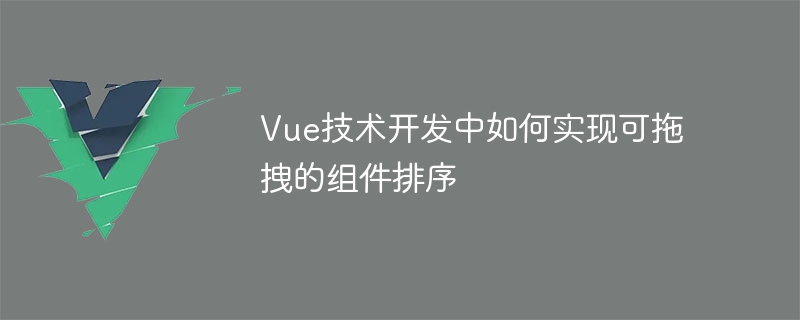Vue技术开发中如何实现可拖拽的组件排序

Vue技术开发中如何实现可拖拽的组件排序
随着Web应用的不断发展,用户对于操作界面的个性化需求也越来越高。其中,可拖拽的组件排序是一种常见且重要的功能。本文将介绍如何利用Vue技术实现可拖拽的组件排序,并提供具体的代码示例。
- 安装依赖
在实现可拖拽的组件排序之前,首先需要安装一些必要的依赖。可以通过以下命令安装Vue、Vue-Sortable和Sortable:
npm install vue vue-sortable sortable --save
- 创建组件
接下来,我们需要创建一个可拖拽的组件。假设我们正在开发一个任务管理应用,我们可以创建一个名为"TaskItem"的组件,该组件用于显示和管理任务。
<template>
<div class="task-item" v-sortable>
<div class="task-content">
<h3 id="task-title">{{ task.title }}</h3>
<p>{{ task.description }}</p>
</div>
</div>
</template>
<script>
export default {
props: {
task: Object
}
}
</script>
<style scoped>
.task-item {
padding: 10px;
border: 1px solid #ccc;
background: #f9f9f9;
cursor: move;
}
.task-content {
margin-bottom: 10px;
}
</style>在上面的代码中,我们使用了v-sortable指令来将组件标记为可拖拽排序的元素。"TaskItem"组件接受一个名为"task"的props,用于显示任务的标题和描述。
- 创建容器组件
除了创建可拖拽的组件外,我们还需要创建一个容器组件来管理多个任务组件的排序。假设我们的容器组件叫做"TaskList"。我们可以在该组件中使用v-for指令来动态绑定多个"TaskItem"组件,并实现排序的功能。
<template>
<div class="task-list">
<task-item
v-for="(task, index) in tasks"
:key="task.id"
:task="task"
@drag-end="onDragEnd(index)"
></task-item>
</div>
</template>
<script>
import TaskItem from './TaskItem'
export default {
components: {
TaskItem
},
data() {
return {
tasks: [
{ id: 1, title: '任务1', description: '这是任务1的描述' },
{ id: 2, title: '任务2', description: '这是任务2的描述' },
{ id: 3, title: '任务3', description: '这是任务3的描述' },
// 其他任务...
]
}
},
methods: {
onDragEnd(index) {
// 更新任务的排序
const [task] = this.tasks.splice(index, 1)
this.tasks.splice(index, 0, task)
}
}
}
</script>
<style scoped>
.task-list {
display: flex;
flex-wrap: wrap;
justify-content: flex-start;
}
</style>在上面的代码中,我们使用了v-for指令来动态绑定多个"TaskItem"组件。通过监听"drag-end"事件,我们可以在拖拽结束时更新任务的排序。
- 应用组件
最后,我们需要将容器组件应用到主组件中,并通过Vue实例进行渲染。
<template>
<div>
<h1 id="任务管理应用">任务管理应用</h1>
<task-list></task-list>
</div>
</template>
<script>
import TaskList from './TaskList'
export default {
components: {
TaskList
}
}
</script>
<style>
h1 {
text-align: center;
margin: 20px 0;
}
</style>在上面的代码中,我们将容器组件"TaskList"通过Vue实例进行渲染,使其成为主组件的一部分。
现在,我们已经完成了可拖拽的组件排序功能的开发。当我们在应用中拖拽任务组件时,它们会根据拖拽的位置重新排序。
综上所述,本文介绍了如何利用Vue技术实现可拖拽的组件排序,并提供了相关的代码示例。通过这种方式,我们可以为用户提供更加灵活和个性化的操作体验。当然,实际应用中还可以根据具体需求进行更多的定制和优化。希望本文对你在Vue技术开发中实现可拖拽的组件排序有所帮助!
以上是Vue技术开发中如何实现可拖拽的组件排序的详细内容。更多信息请关注PHP中文网其他相关文章!

热AI工具

Undresser.AI Undress
人工智能驱动的应用程序,用于创建逼真的裸体照片

AI Clothes Remover
用于从照片中去除衣服的在线人工智能工具。

Undress AI Tool
免费脱衣服图片

Clothoff.io
AI脱衣机

Video Face Swap
使用我们完全免费的人工智能换脸工具轻松在任何视频中换脸!

热门文章

热工具

记事本++7.3.1
好用且免费的代码编辑器

SublimeText3汉化版
中文版,非常好用

禅工作室 13.0.1
功能强大的PHP集成开发环境

Dreamweaver CS6
视觉化网页开发工具

SublimeText3 Mac版
神级代码编辑软件(SublimeText3)
 vue中怎么用bootstrap
Apr 07, 2025 pm 11:33 PM
vue中怎么用bootstrap
Apr 07, 2025 pm 11:33 PM
在 Vue.js 中使用 Bootstrap 分为五个步骤:安装 Bootstrap。在 main.js 中导入 Bootstrap。直接在模板中使用 Bootstrap 组件。可选:自定义样式。可选:使用插件。
 vue怎么给按钮添加函数
Apr 08, 2025 am 08:51 AM
vue怎么给按钮添加函数
Apr 08, 2025 am 08:51 AM
可以通过以下步骤为 Vue 按钮添加函数:将 HTML 模板中的按钮绑定到一个方法。在 Vue 实例中定义该方法并编写函数逻辑。
 vue中的watch怎么用
Apr 07, 2025 pm 11:36 PM
vue中的watch怎么用
Apr 07, 2025 pm 11:36 PM
Vue.js 中的 watch 选项允许开发者监听特定数据的变化。当数据发生变化时,watch 会触发一个回调函数,用于执行更新视图或其他任务。其配置选项包括 immediate,用于指定是否立即执行回调,以及 deep,用于指定是否递归监听对象或数组的更改。
 vue多页面开发是啥意思
Apr 07, 2025 pm 11:57 PM
vue多页面开发是啥意思
Apr 07, 2025 pm 11:57 PM
Vue 多页面开发是一种使用 Vue.js 框架构建应用程序的方法,其中应用程序被划分为独立的页面:代码维护性:将应用程序拆分为多个页面可以使代码更易于管理和维护。模块化:每个页面都可以作为独立的模块,便于重用和替换。路由简单:页面之间的导航可以通过简单的路由配置来管理。SEO 优化:每个页面都有自己的 URL,这有助于搜索引擎优化。
 vue返回上一页的方法
Apr 07, 2025 pm 11:30 PM
vue返回上一页的方法
Apr 07, 2025 pm 11:30 PM
Vue.js 返回上一页有四种方法:$router.go(-1)$router.back()使用 <router-link to="/"> 组件window.history.back(),方法选择取决于场景。
 React与Vue:Netflix使用哪个框架?
Apr 14, 2025 am 12:19 AM
React与Vue:Netflix使用哪个框架?
Apr 14, 2025 am 12:19 AM
NetflixusesAcustomFrameworkcalled“ Gibbon” BuiltonReact,notReactorVueDirectly.1)TeamExperience:selectBasedAsedonFamiliarity.2)ProjectComplexity:vueforsimplerprojects,vueforsimplerprojects,reactforforforecomplexones.3)cocatizationNeedsneeds:reactofficatizationneedneeds:reactofferizationneedneedneedneeds:reactoffersizatization needeffersefersmoreflexiblesimore.4)ecosyaka
 vue遍历怎么用
Apr 07, 2025 pm 11:48 PM
vue遍历怎么用
Apr 07, 2025 pm 11:48 PM
Vue.js 遍历数组和对象有三种常见方法:v-for 指令用于遍历每个元素并渲染模板;v-bind 指令可与 v-for 一起使用,为每个元素动态设置属性值;.map 方法可将数组元素转换为新数组。
 vue的div怎么跳转
Apr 08, 2025 am 09:18 AM
vue的div怎么跳转
Apr 08, 2025 am 09:18 AM
Vue 中 div 元素跳转的方法有两种:使用 Vue Router,添加 router-link 组件。添加 @click 事件监听器,调用 this.$router.push() 方法跳转。






